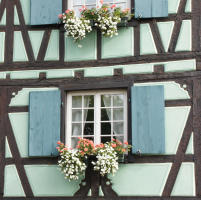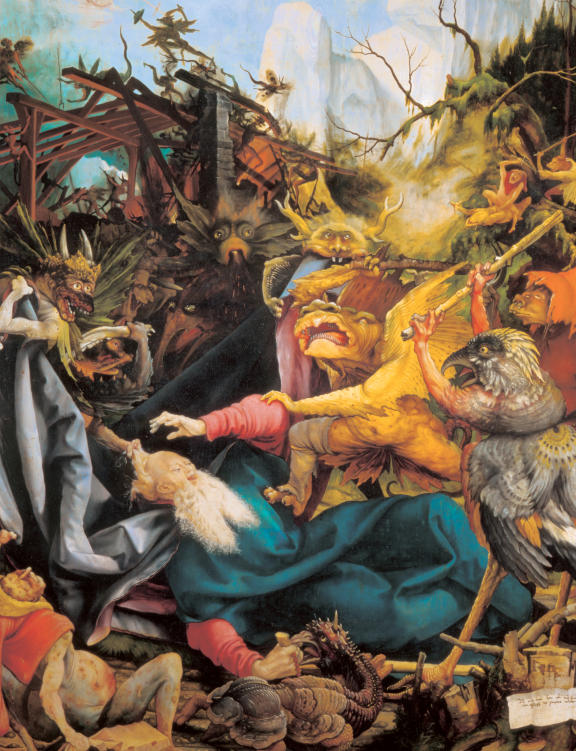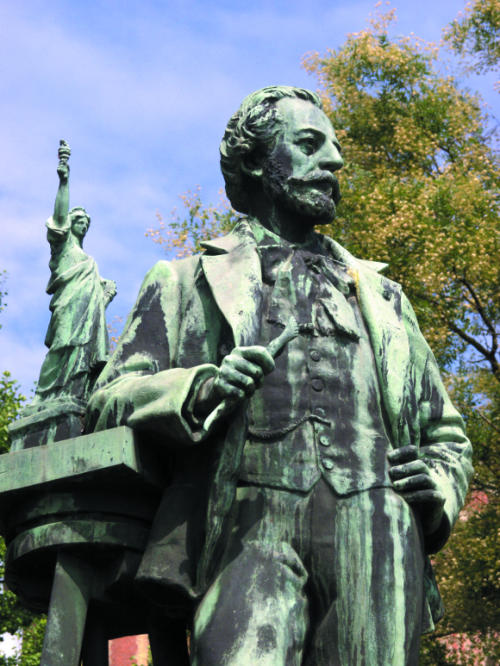
Colmar lacked color on the cool grey day and damp night that I visited in February. Of course I knew before coming that this wasn’t a February destination. March perhaps, April why not, May certainly, etc. But between end of at the December Christmas markets that spread bright winter cheer through the town center and the first hints of spring, Colmar turns inward, some museums, hotels and restaurants close, and a visitor is left to fend for himself.
Anyway, I hadn’t come to Colmar to recommend the season but rather to briefly visit the town before going to Kaysersberg on the Alsace wine route to examine the Nasti family ventures there. Colmar is capital of Upper Rhine (the southern portion of Alsace) and unofficial capital of the Alsace wine region.
If I were inclined to let the way-off-season fully color my description of Colmar then it’s unlikely that I’d ever get over the view of Christmas trees that should have long been removed, leaning over on their stands on a ledge over the Lauch River by the covered market, looking like someone’s sad childhood memory. But I’m not that kind of guy.

Inside the covered market the market was very much alive. And throughout the old town, the pastel colored half-timbered houses were still unmistakably Alsatian, even if the geranium boxes, a regional signature, had been brought in for the winter. The Pfister Mansion (1537) and the House of Heads (1609) continued to speak of the wealth of merchants of centuries past.
I wore a coat while visiting the Unterlinden Museum, which occupies a 13th-century Dominican convent and which led me to think not of cold nuns but of hallucinating gangrene peasants. Why? Because Matthias Grunewald’s altarpiece, the museum’s piece de resistance, was created 500 years ago for a hospital in Issenheim that especially housed those suffering from poisoning from ergot, a fungus that develops in rye plant and thus transmitted through rye bread, a disease known as Saint Anthony’s fire.

The Issenheim Altarpiece is an extraordinarily expressive work of faith and disease, of hope and pain, and of pride and frailty. A traveler needn’t be especially fond of altarpieces or of early 16th-century religious art to be drawn into its scenes and colors and characters, especially with a knowledgeable guide or audio-guide. The altarpiece is the Mona Lisa of Colmar, both for its fame and for the fact that both works were created at about the same time in two very different cultures.
In February the Bartholdi Museum looked as though no one much cared anymore that Auguste Bartholdi (1834-1904), who was born here, created the Mona Lisa of New York Harbor—The Statue of Liberty, aka Liberty Enlightening the World (1870-1886), whose copper skin hangs on a frame designed by Gustave Eiffel. A maintenance workr opened the doors and turned on the lights for me. I suspect that the museum doesn’t look very sprightly during the opening months of March through December either, just with better lighting. Still this is the chance to learn something of the man and to see a plaster cast of Liberty’s ear.

Furthermore, the seven monuments that he designed for Colmar can be seen when exploring the town. His most famous work in France is the Mona Lisa of Belfort—the Lion of Belfort (1870s)—in which a wounded lion, struggling to rise, represents the town of Belfort in its resistance to Prussian attacks during the France-Prussian War. The original is made of stone, while a bronze copy stands on Place Denfert-Rochereau in Paris’s 14th arrondissement. Bartholdi’s statue of Lafayette and Washing stands in the shade on Place des Etats-Unis in Paris’s 16th arrondissement.
Also closed during my visit, with no maintenance man in sight to let me in, was the Gothic Dominicans’ Church that houses Martin Schongauer’s The Madonna of the Rose Bush, 1473, Colmar’s second most popular chef d’oeuvre. I nevertheless give it a shout-out here ‘cause she’s so purty.

In February it was too early in the year to watch folk dancing in the streets or to sit outside in the cafes of the old town. But it was the season to enjoy a nice selection of coffee (and pastries) at the Colmar venue of the regional roaster/coffee (and tea) room with the politically incorrect name Les Cafés au Bon Nègre, upstairs at 9 rue des Tetes.

I stayed at the 4-star Hotel Marechal, a fine old-fashion romantic Alsatian hotel alongside the narrow Lauch River near the center of the old town. I could tell that I wasn’t in a standardized hotel as soon as I tried to find my room in the maze of hallways upstairs. The 24 rooms, named for composers, each has its own eclectic and more or less baroque style. The larger doubles, some with canopy beds, and the suites have Jacuzzi bathtubs. Prices varying in keeping with the wide variety of sizes, from 105€ to 255€ per night, plus 15€ with breakfast.
The hotel’s restaurant A L’Echevin has a sliver of seating overlooking the river. While there is more innovative cuisine served elsewhere in town, the setting and the classically polished cooking makes it a worthwhile stop whether staying at the hotel or not. The wine-paired tasting menu that evening maintained its good quality throughout (calf’s sweetbreads and crayfish with morel sauce; gilthead on a tomato and olive pie; duck breast with turnips and mashed celery; chocolate cake with strawberries and a green pepper sauce served with white chocolate ice cream). I hadn’t come to Colmar intent on reviewing the restaurant and so was pleasantly surprised by the quality.
Hotel Le Maréchal – Restaurant A L’Echevin, 4/6 place des Six Montagnes Noires, 68000 Colmar. Tel. 03 89 41 60 32. See the hotel’s website for the current menu. The restaurant is open daily.
Unterderlinden Museum, 1 rue d’Unterlinden. Open May to Oct. daily 9am-6pm, Nov.-April daily except Tues. 9am-noon and 2-5pm. The Unterlinden is currently under renovation and expansion into the former public baths of Colmar, taking place from May 2012 to November 2013, but that’s not expected to affect the visibility of the altarpiece and other major pieces of the museum.
Bartholdi Museum, 26 rue des Marchands. Open daily May-Oct. and daily except Tuesday the rest of the year.
Dominicans’ Church, Place des Dominicains. Open April-Dec. 10am-1pm and 3-6pm, open without pause Fri. and Sat. from May to Oct..
Colmar Tourist Office, 4 rue Unterlinden.
© 2012, Gary Lee Kraut

